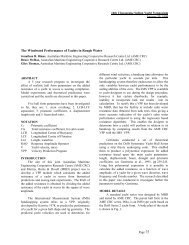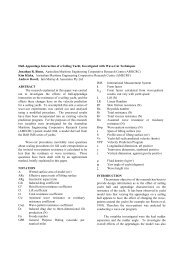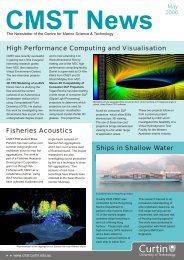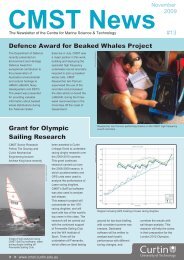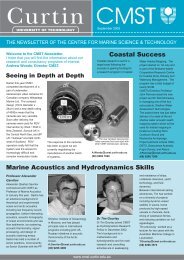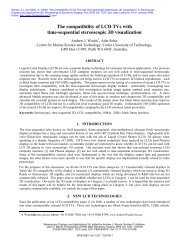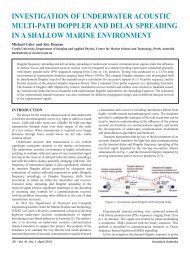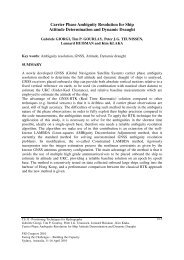Blue whale calling in the Rottnest trench-2000, Western ... - ANP
Blue whale calling in the Rottnest trench-2000, Western ... - ANP
Blue whale calling in the Rottnest trench-2000, Western ... - ANP
You also want an ePaper? Increase the reach of your titles
YUMPU automatically turns print PDFs into web optimized ePapers that Google loves.
Figure 25: Output of RAM for 200 m thick Leeuw<strong>in</strong> current, 24 Hz, 450 m receiver, 40 m source and bathymetry<br />
tracks 5 (solid l<strong>in</strong>e) an 6 (dotted l<strong>in</strong>e).<br />
To give a statistical probability that a received level was with<strong>in</strong> some def<strong>in</strong>ed range of <strong>the</strong> bluey<br />
logger <strong>the</strong> follow<strong>in</strong>g steps were taken for each of <strong>the</strong> eight bathymetry tracks (Figure 16):<br />
• threshold received levels were chosen from 100 to 130 dB re 1μPa <strong>in</strong> 2.5 dB <strong>in</strong>crements<br />
( t i );<br />
• for each threshold level <strong>the</strong> ranges at which <strong>the</strong> RAM predicted received level equalled or<br />
exceeded <strong>the</strong> threshold level were found ( r n );<br />
• for each threshold level <strong>the</strong> number of RAM range po<strong>in</strong>ts equall<strong>in</strong>g or exceed<strong>in</strong>g <strong>the</strong><br />
threshold level ( r n ) <strong>in</strong> 250 m b<strong>in</strong> <strong>in</strong>crements from 0 to <strong>the</strong> bathymetry profile length (37-50<br />
km) were found ( n i );<br />
• for each threshold level <strong>the</strong> cumulative sum vector of i n was calculated (ie ci<br />
∑ni<br />
where<br />
28<br />
x<br />
=<br />
x was <strong>the</strong> total number of b<strong>in</strong>s or 250 m steps <strong>in</strong> <strong>the</strong> bathymetry path length) ;<br />
• and <strong>the</strong> 95% po<strong>in</strong>t of this vector c i found to give <strong>the</strong> range with<strong>in</strong> which 95% of all<br />
components for <strong>the</strong> given threshold and bathymetry path occurred.<br />
The result<strong>in</strong>g curves giv<strong>in</strong>g <strong>the</strong> 95% probability of detection range for <strong>the</strong> type II component on<br />
<strong>the</strong> eight path lengths for <strong>the</strong> bluey logger site and a 200 m deep Leeuw<strong>in</strong> current, are shown on<br />
Figure 26. Although for several of <strong>the</strong> paths <strong>the</strong> detection range for <strong>the</strong> lower threshold levels is<br />
dependant on <strong>the</strong> total path length used (ie. < 107.5 dB re 1μPa for > 47 km path 5), it is clear<br />
that <strong>the</strong> propagation of <strong>the</strong>se signals to <strong>the</strong> bluey logger site is excellent. This is notable on paths<br />
4, 5, and 6. Paths 4-6 face <strong>the</strong> opposite side of <strong>the</strong> <strong>trench</strong> on head<strong>in</strong>gs 135, 180 and 215 degrees<br />
from <strong>the</strong> bluey site respectively. Paths 1-4 all run up <strong>in</strong>to shallow water thus <strong>the</strong> transmission of<br />
<strong>the</strong> 18-26 Hz signal would be expected to at some po<strong>in</strong>t drop rapidly, which it does.<br />
The same propagation modell<strong>in</strong>g exercise as described above was carried out for: a Leeuw<strong>in</strong><br />
current of 75 m thickness, source depth of 40 m: and a Leeuw<strong>in</strong> current of 200 m thickness and<br />
source depth of 20 m. The result<strong>in</strong>g 95% probability of detection ranges are shown on Figure 27<br />
and Figure 28 respectively.<br />
1



